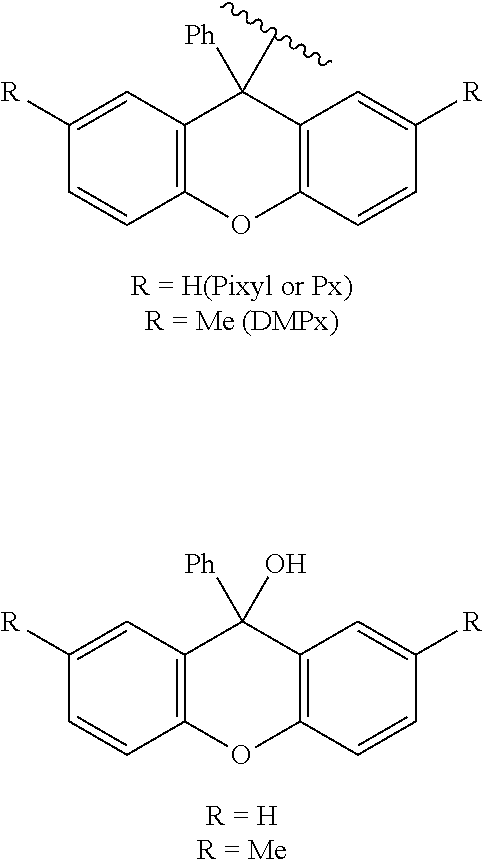Method of solid-phase nucleic acid synthesis and solution composition for solid-phase nucleic acid synthesis
a solid-phase nucleic acid and nucleic acid synthesis technology, applied in the direction of sugar derivates, peptides, bulk chemical production, etc., can solve the problems of difficult separation from other organic solvents, difficulty in recovering toluene, and problematic use of toluene in solid-phase nucleic acid synthesis methods, etc., to achieve increased recovery cost, increased recovery cost, and high acidity
- Summary
- Abstract
- Description
- Claims
- Application Information
AI Technical Summary
Benefits of technology
Problems solved by technology
Method used
Image
Examples
example 11
[0052]In Example 1, Nitto Phase HL comprising, carried thereon, T to which a dimethyltrytyl group (a protecting group) had bound was used, and a reaction of removing a protecting group was examined using various solvents in combination with acid substances. In Example 1, acetonitrile, acetone, ethyl acetate, DMF, DMSO, hexane, methanol, and ethanol were prepared as candidate solvents. In addition, dichloroacetic acid (DCA), trichloroacetic acid (TCA), trifluoroacetic acid (TFA), p-toluenesulfonic acid (PTSA), and hydrochloric acid were prepared as acid substances.
Experimental Procedure 1
[0053]Candidate solvents were mixed with acid substances in the manner described below.
Preparation of Solutions of Candidate Solvents Containing 3% DCA:
[0054]DCA (1.5 ml) was added to a 50-ml volumetric flask using a measuring pipette. The 50-ml volumetric flask was filled with the solutions.
Preparation of 50% Mixed Solutions of Toluene and Candidate Solvents Containing 3% DCA:
[0055]DCA (1.5 ml) was ...
example 2
[0064]In Example 2, solid-phase nucleic acid synthesis was carried out using trichloroacetic acid (TCA), trifluoroacetic acid (TFA), p-toluenesulfonic acid (PTSA), and hydrochloric acid subjected to primary screening in Example 1 in the step of deprotection, and the purity of the synthesized nucleic acids was evaluated.
Experimental Procedure
[0065]In Example 2, nucleic acid synthesis was carried out using an AKTA 10 synthesizer (Amersham Biosciences). A 1.2-ml stainless steel column (diameter: 1 cm; height: 1.5 cm) was used. A nucleic acid sequence to be synthesized was designated as 5′-ATA CCG ATT AAG CGA AGT TT-3′ (SEQ ID NO: 1). As a solid-phase support, 350 to 370 μmol / g Nitto Phase HL (Nitto Denko Corporation) was used. In addition, nucleic acid synthesis was carried out by removing a protecting group (a DMT group) from a base at the terminus, and amine wash was carried out using 0.1 N diazabicycloundecene for 30 minutes. As an activator, 5-ethylthio-1-tetrazole (ETT) was used. ...
example 3
[0073]In Example 3, solid-phase nucleic acid synthesis was carried out in the same manner as in Example 2, except that a length of the column used in the reaction of nucleic acid synthesis was increased from 4 cm to 8 cm, and the purity of the synthesized nucleic acids was evaluated. In Example 3, the step of deprotection was carried out using a 3% DCA / toluene solution (linear velocity: 400 cm / h) or a 9% TCA / acetonitrile solution (linear velocity: 800 cm / h).
[0074]When a solid-phase support comprising porous resin beads (e.g., Nitto Phase HL) is used, the upper limit of the liquid flow rate is 400 cm / h with the use of a DCA / toluene solution as a deprotection solution for the following reasons. That is, porous resin beads are swollen and softened in a toluene solution, a spherical form cannot be retained due to the pressure applied at a high flow rate, and the flow pass is blocked. When a TCA / acetonitrile solution is used, in contrast, a degree of swelling of porous resin beads in ace...
PUM
| Property | Measurement | Unit |
|---|---|---|
| pKa | aaaaa | aaaaa |
| length | aaaaa | aaaaa |
| pKa | aaaaa | aaaaa |
Abstract
Description
Claims
Application Information
 Login to View More
Login to View More - R&D
- Intellectual Property
- Life Sciences
- Materials
- Tech Scout
- Unparalleled Data Quality
- Higher Quality Content
- 60% Fewer Hallucinations
Browse by: Latest US Patents, China's latest patents, Technical Efficacy Thesaurus, Application Domain, Technology Topic, Popular Technical Reports.
© 2025 PatSnap. All rights reserved.Legal|Privacy policy|Modern Slavery Act Transparency Statement|Sitemap|About US| Contact US: help@patsnap.com

